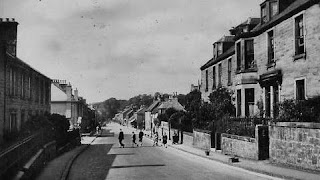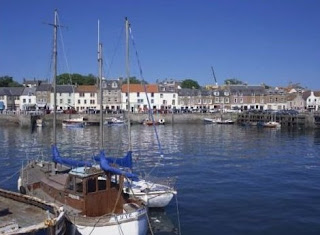Sir David Lyndsay, l490-1555, Poet and dramatist. He was the eldest son of David Lyndsay of the Mount, an estate in the Howe of Fife near Cupar. His father also possessed land in East Lothian and it is uncertain whether Lyndsay was educated there at the Grammer School of Haddington or at Cupar. Little is known of his early life, he may have attended the University of St Andrews, but by 1511 he was at the court of James IV. On the birth of Prince James in 1512 Lyndsay was appointed a Gentleman-usher, and throughout the young prince's childhood he was in continuous personal attendance on him. Following the accession of James V as King of Scots in 1524, and the supremacy at court of the Douglases, Lyndsay was banished to his estate at Garmylton in East Lothian. At the beginning of James's personal rule in 1529 Lyndsay was restored to favour and knighted; it was probably at this time that he was created Lyon King of Arms and became an emissary for the young king in his relationships with France, Spain and England. When James married Mary of Guise-Lorraine in 1538 Lyndsay was involved with the marriage preparations, and it was for the royal court that his play Ane Pleasant Satyre Of The Thrie Estaitis was performed on Twelfth Night 1540 in Linlithgow. James's death in 1542 did not diminish Lyndsay's standing, and in 1548 he was employed on an embassy to the court of Denmark. The last reference to Lyndsay at Court is in January 1555, when he presided over a chapter of heralds in Edinburgh; in April of the same year his death was recorded in the Register of the Privy Seal. Lyndsay probably started writing during his first stay at court and during his exile in East Lothian. In his earliest work. The Dreme (1528), he introduces himself as James V's servant and the teller of stories (of which this is presented as one) to the young king. It is a dream allegory, concerned with Scotland and its proper governance. The poet falls asleep in a cave and in a dream Dame Remembrance leads him to hell and purgatory, and to a glimpse of heaven and the Garden of Eden, before showing him the ruin that Scotland has become despite its apparent prosperity. John the Common-Weill, who later appears in the Thrie Estaitis, is introduced and bewails the laziness, falsehood, pride and greed into which Scotland has fallen. The poem ends with an exhortation to the king to remember the importance of his high office, a recurring motif in Lyndsay's work. The Complaynt of the King (1529) deals with similar themes in a work that is also a petition to the king for patronage. Lyndsay's most adventurous long poem, The Testament and Complaynt of Our Soverane Lords Papyngo, was published in 1538 but had been completed as early as 1530. It is divided into five sections concluding with two stanzas, one addressed to the reader and the other to the book. The poet, having taught the king's 'papyngo', or parrot, to speak, sees it mortally wounded after falling from a tree, but instead of helping the bird, he hides behind a hawthorn tree. After calling for a priest, the papyngo bemoans her misfortune - 'who sitteth most hie, sal find the saite moist slide' — and in so doing reminds the king of his awesome responsibilities to his people. Three birds, the Pie (canon regular), the Raven (black monk) and the Kite (holy friar), arrive to administer the last rites, but they ignore the papyngo's wishes and on her death they tear up the body, the Kite making off with her heart. Another animal poem The Complaynt and Publict Confessioun of the Kingis Auld Hound callit Bagsche (1536) allows Bagsche to complain about his fall from grace and to offer a solemn warning about hubris to Bawtie his successor. The Historic of ane Nobilland Vailyeand Squyer, William Meldrum, umquhyle Laird of Cleische and Bynnis (1547) shows Lyndsay's skill as a polished raconteur in the tale of the amorous and valiant knight, Squire Meldrum. The poem falls into two parts: 'The Historic', in rhyming octosyllabic couplets, traces Meldrum's career as lover and soldier; and 'The Testament', in Chaucerian ballat royal describes Meldrum's funeral and pronounces his recorded wish that the procession should reflect his interests in love and war. These are Lyndsay's most important poems: the others, all worthy of note, are: Ane Answer quhilk Schir David Lyndesay maid to the Kingis Fly ting (1536), a ribald riposte to a poem by James that has not been preserved; The Deploratioun of the Deith of Queue Magdalene(1537), a lament on the death of James's first queen; The Justing betuix James Watsoun and Jhone Barbour Servitouris to King James the Fyft (1538), a mock-heroic account of a jousting match which formed part of the marriage festivities of James to Mary of Guise-Lorraine; Ane Supplication Directit to the Kingis Grace in Contemplatioun of Syde Taillis (1538), an amusing plea to the king to enforce the wearing by women of shorter gowns; Kitteis Confessioun (c1542), an attack on the clergy's abuse of the privacy of confession; The Tragedie of the Cardinal! (1547), in which the shade of Cardinal Beaton makes apology for earthly misdeeds; and Ane Dialog betuix Experience and ane Courteour (1553), Lyndsay's last and longest poem in seven books which is an amalgam of his philosophy and an apologia pro vita sua. The work on which Lyndsay's literary reputation rests is also the first great play in Scottish drama: Ane Pleasant Satyre of the Thrie Estaitis in Commendatioun of Vertew and Vituperatioun of Vyce. The play gathers together in a dramatic unity many of Lyndsay's main public concerns: the abuse of spiritual and temporal power, the role of the king as head of the body politic, greed and lechery within the Church, and the oppression of the Scottish people by the nobility and the burgesses. Rex Humanitas is beguiled by the Vices who also hold in thrall the three estates, the clergy, the nobility and the burgesses. It is left to John the Common-Weill, a powerful manifestation of the levelling power of democracy, to unmask their crimes and to reorder society. Lyndsay's use of allegorical figures and his mixture of comedy and moral seriousness makes the Thrie Estaitis not only a powerful piece of drama but also a telling satirical commentary on the vices of spiritual and secular society of Lyndsay's time.
A reformer by inclination but, as far as is known, a Catholic by persuasion, Lyndsay was an early supporter of John Knox. In his Historia George Buchanan praised Lyndsay for his integrity and truthfulness, traits also noted by the monarchs to whom he was ambassador; ,and his support of the commons was no empty gestur his work resounds to his distaste for the corruption of power and to his acknowledgement of the grievances suffered by the ordinary people. Works include; The Dreme of Sir David Lyndsay (1528); The Complaynt of the King (1529); Ane Answer quhilk Schir David Lyndesay maid to the Kingis Flyting (1536); The Complaynt and Publict Confessioun of the Kingis Auld Hound callit Bagsche (1536); The Deploratioun of the Deith of Quene Magdalene (1537); The Justing betuix James Watsoun and Jhone Barbour Servitouris to King James the Fyft (1538); Ane Supplicatioun Directit to the Kingis Grace in Contemplatioun of Syde Taillis (1538); The Testament and Complaynt of Our Soverane Lordis Papyngo (1538); Kitteis Confessioun (cl542); The Tragedie of the Late Cardinall (1547); The Historic of ane Nobill and Vailyeand Sauyer, Willam Meldrum, umquhyle Laird of Cleische and Bynnis (1547); Acta sui temporis (1548); Ane Dialog betuix Experience and ane Courteour (1553); Ane Pleasant Satyre of the Thrie Estaitis (1602).
Tour Howe of Fife,
Fife, Scotland, on an
Ancestry Tour of Scotland.
Best Scottish Tours,
Best Scottish Food,
Best Scottish Hotels,
Small Group Tours of Scotland,
Rent a Cottage in Scotland.
Golf Scotland.
Tour Roman Scotland.
Tour Scotland.
Ancestry Research Scotland,
Birdwatching Scotland,
Guidebooks Scotland,
Edinburgh Travel Guides,
Coast Scotland,
Scotland Maps,
Self Catering Scotland, Tour Scotland.















